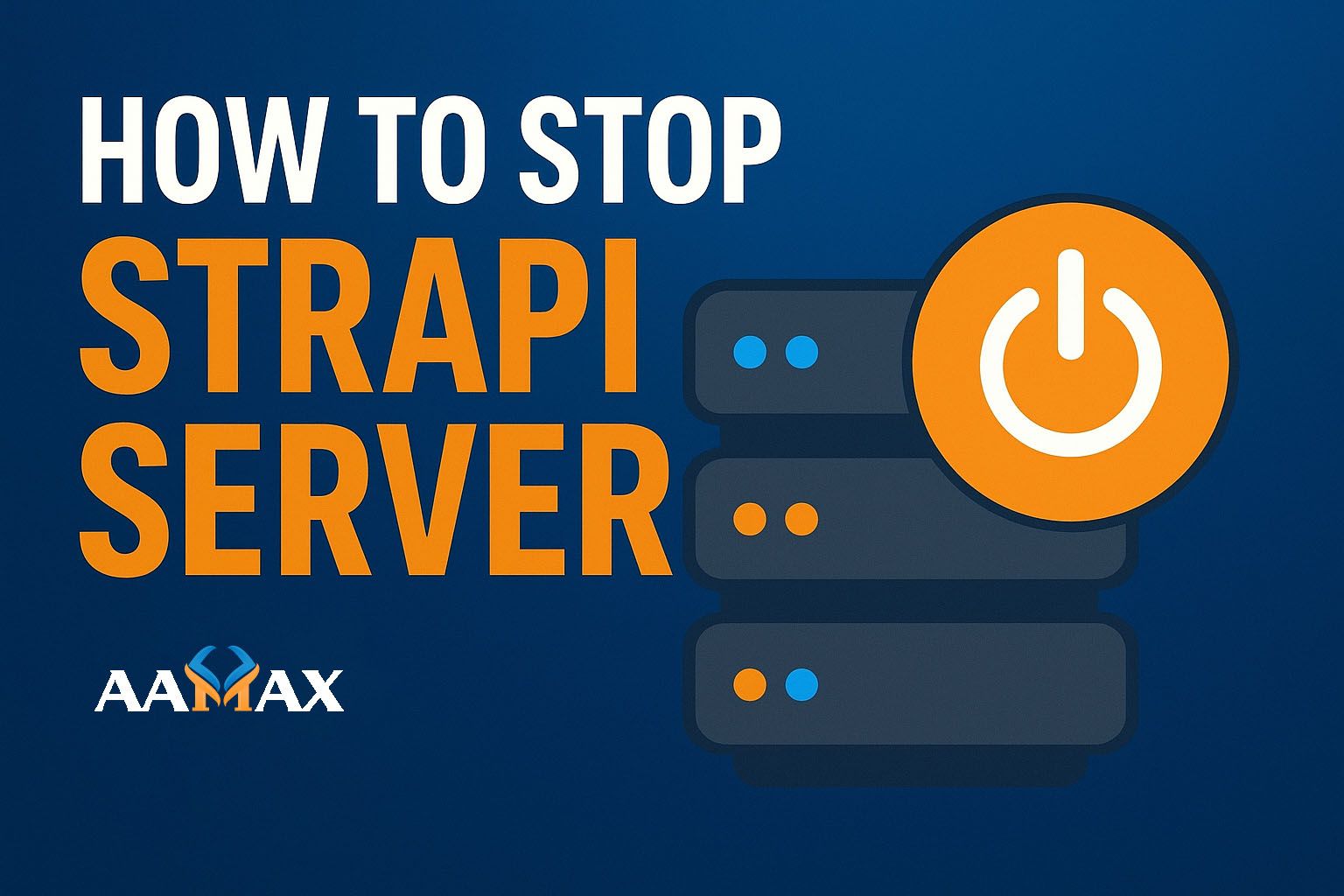
How to Stop Strapi Server
Stopping a Strapi server may seem like a simple task, but anyone who has worked on a production-grade backend project knows that even basic operations like shutting down the server require careful handling. Whether you're running Strapi in development, staging, or production mode, knowing the correct ways to stop, restart, or gracefully shut down the server is crucial for maintaining optimal performance, preventing data loss, and ensuring stability across your environment. In this detailed guide, we will explore multiple methods for stopping the Strapi server effectively, explain when to use each method, and share best practices for maintaining a healthy workflow. If you ever need expert help with building Strapi or full MERN stack solutions, consider hiring AAMAX, a full-service digital marketing and web development company offering Web Development, Digital Marketing, and SEO services.
Understanding How Strapi Runs
Before diving into ways to stop the Strapi server, it's important to understand how Strapi operates. Strapi is a powerful open-source headless CMS built on Node.js. It allows developers to build scalable APIs using flexible content structures. Strapi can run in multiple modes: - Development Mode - Production Mode - Custom Environments
Each mode has its own server behavior, logging level, hot-reloading availability, and configuration handling. Because Strapi runs as a Node.js server, it responds to general Node.js process commands while also providing its own scripts through npm or yarn.
Understanding Strapi's runtime behavior helps you choose the right method to stop the server depending on your operating system, environment, and use case.
Stopping Strapi When Running in Development Mode
Most developers run Strapi in development mode using:
npm run develop
or
yarn develop
In development mode, Strapi uses hot-reloading and runs actively in your terminal window. This is the easiest mode to stop.
Method 1: Pressing CTRL + C in Terminal
The universal and most common way to stop a Strapi server is:
Windows / macOS / Linux
CTRL + C
This sends a termination signal (SIGINT) to the Node.js process, which
shuts down the server gracefully.
How Graceful Shutdown Works
A graceful shutdown means: - Ongoing requests are completed. - File watchers stop safely. - Database connections are closed properly. - Strapi exits without breaking the environment.
This method is ideal during development since it allows Strapi to clean up everything properly.
Method 2: Closing the Terminal Window
While not recommended unless necessary, closing the terminal window also forces the Strapi development server to stop. However, this is a more abrupt kill and does not always allow graceful shutdown.
Use this only when: - Your terminal freezes. - Keyboard input is not responding. - You need a quick emergency stop.
Stopping Strapi When Running in Production Mode
Production mode behaves differently from development mode. Developers usually use:
npm run start
or
yarn start
In this mode, Strapi does not watch for file changes, and it must be stopped carefully.
Method 1: CTRL + C (If Running in Foreground)
If the server is running in the foreground, the same command applies:
CTRL + C
This sends a proper shutdown signal and is safe to use.
Method 2: Using PM2 or Another Process Manager
Production environments commonly use PM2 to manage Node.js applications. If Strapi is running under PM2, you must stop it using PM2 commands rather than CTRL + C.
Common commands:
List PM2 processes:
pm2 list
Stop Strapi by name:
pm2 stop strapi
Stop by process ID:
pm2 stop <id>
Restart a stopped process:
pm2 restart strapi
Remove it completely from PM2:
pm2 delete strapi
Using PM2 ensures: - Automatic restarts upon failure. - Log management. - Proper clustering support. - Background running without manual terminal attachment.
Method 3: Killing the Node Process (Advanced)
If Strapi becomes unresponsive, you may need to kill the Node.js process directly.
Linux / macOS:
ps aux | grep strapi
kill -9 <PID>
Windows (PowerShell):
Get-Process node
Stop-Process -Id <PID> -Force
Force-killing should only be used as a last resort, as it does not allow Strapi to shut down gracefully.
Stopping Strapi Server When Port Is Stuck or Busy
Sometimes the Strapi server does not shut down correctly, leaving the port (default 1337) in use.
Error Example:
Error: listen EADDRINUSE: address already in use 1337
Fix for Linux / macOS
lsof -i :1337
kill -9 <PID>
Fix for Windows
Using Command Prompt:
netstat -ano | findstr :1337
taskkill /PID <PID> /F
After stopping the stuck process, you can start Strapi again normally.
Stopping Strapi in a Docker Environment
If you're running Strapi inside a Docker container, the process management is handled by Docker itself.
Stop a single container:
docker stop strapi-container
Stop and remove the container:
docker rm -f strapi-container
Stop all running containers:
docker stop $(docker ps -q)
Stopping Strapi in Docker is safer than killing Node processes directly because Docker handles cleanup automatically.
Stopping Strapi in a Kubernetes Cluster
For cloud-native deployments, Strapi may run inside Kubernetes pods.
Identify pods:
kubectl get pods
Delete a specific Strapi pod:
kubectl delete pod strapi-pod
Kubernetes will usually restart another pod automatically depending on deployment settings.
Scale Strapi to zero replicas:
kubectl scale deployment strapi --replicas=0
This is the safest way to shut down a Strapi instance in a cluster environment.
Stopping Strapi When Running With Nodemon
Although Strapi does not require Nodemon (because it includes its own watcher), some developers use it.
If running:
nodemon server.js
You can stop it using:
CTRL + C
Or kill Nodemon specifically:
pkill -f nodemon
Stopping Strapi When Running in Background on Linux
Running Strapi in background:
npm run develop &
To stop it:
jobs
kill %1
Or:
pkill node
Always use caution when using pkill, as it terminates all Node
processes.
Understanding SIGINT, SIGTERM, and SIGKILL
Node.js servers respond to different kill signals.
SIGINT
Triggered by:
CTRL + C
Gracefully stops the server.
SIGTERM
Used by:
kill <PID>
Graceful if supported; otherwise forced.
SIGKILL
Forced stop:
kill -9 <PID>
Does not allow cleanup. Should be avoided unless absolutely necessary.
Understanding these signals helps you decide the safest way to shut down Strapi.
Stopping Strapi Programmatically
Developers sometimes embed Strapi inside other Node.js services.
Example:
const strapi = require('@strapi/strapi');
let app;
async function start() {
app = await strapi().load();
await app.start();
}
async function stop() {
await app.destroy();
}
process.on('SIGINT', stop);
process.on('SIGTERM', stop);
start();
This allows the application to clean up gracefully when receiving kill signals.
Restarting Strapi After Stopping It
Development restart:
npm run develop
Production restart:
npm run start
PM2 restart:
pm2 restart strapi
Docker restart:
docker restart strapi-container
Restarting ensures that cached data, file changes, and configurations reload properly.
Best Practices for Stopping Strapi Safely
Stopping a server correctly helps maintain a clean development workflow.
1. Always use CTRL + C first
It's the safest and simplest method.
2. Avoid force-killing unless necessary
Use kill -9 only when Strapi is stuck.
3. Use PM2 for production
It handles: - Logs - Crashes - Restarts - Graceful shutdowns
4. Make sure database connections close properly
Stopping Strapi abruptly can leave: - open connections - locked tables - unsaved transactions
5. Clear cache when needed
Sometimes after stopping Strapi, clearing cache helps:
rm -rf .cache build
6. Monitor ports regularly
A stuck port can block your development flow.
7. Document server commands in your project
Teams work better when everyone follows the same process.
Troubleshooting Common Shutdown Problems
Stopping Strapi may sometimes cause unexpected issues.
Problem: Server Freezes When Stopping
Fix:
killall node
Problem: Admin Panel Still Shows Running
Clear browser cache or restart Strapi cleanly.
Problem: Changing Code Prevents Shutdown
Strapi may restart itself due to watchers. Press CTRL + C twice.
Problem: Database Keeps Locking Files
Especially with SQLite:
rm .tmp/data.db-journal
Problem: Docker Container Won't Stop
Force stop:
docker rm -f strapi-container
Understanding these issues prevents wasted development time.
Conclusion
Knowing how to stop the Strapi server safely is just as important as knowing how to start it. Whether you're running Strapi in development mode, managing multiple environments with PM2, working inside Docker or Kubernetes, or handling automated infrastructure, choosing the right shutdown method ensures data integrity and prevents unexpected issues. A clean shutdown supports a smooth development workflow, reduces bugs, and maintains system reliability.
If you want to build scalable Strapi applications, custom APIs, or MERN Stack Development, consider hiring AAMAX, a full-service digital agency offering Web Development, Digital Marketing, and SEO services. Their expertise can help accelerate your development, optimize your backend infrastructure, and ensure professional results.







